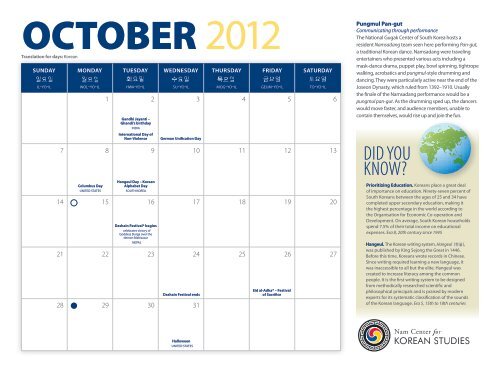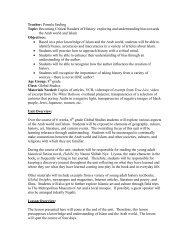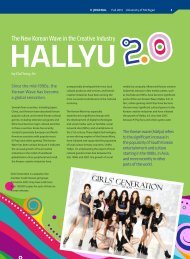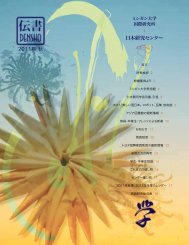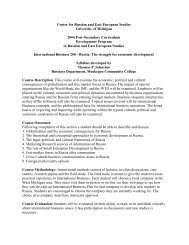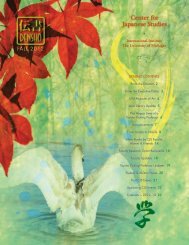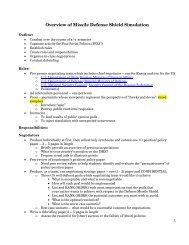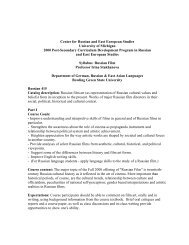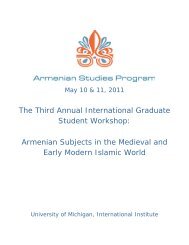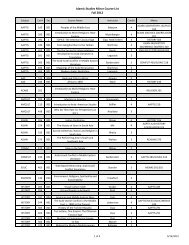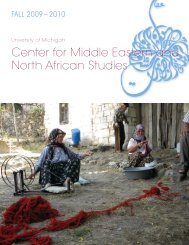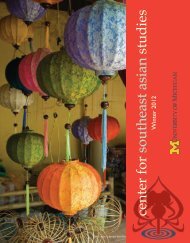2012/2013 Academic Year Calendar - International Institute ...
2012/2013 Academic Year Calendar - International Institute ...
2012/2013 Academic Year Calendar - International Institute ...
You also want an ePaper? Increase the reach of your titles
YUMPU automatically turns print PDFs into web optimized ePapers that Google loves.
OCTOBER <strong>2012</strong><br />
Translation for days: Korean<br />
SUNDAY<br />
il-yo-il<br />
7<br />
14<br />
21<br />
28<br />
MONDAY<br />
wol-yo-il<br />
Columbus Day<br />
UNITED STATES<br />
1<br />
8<br />
15<br />
22<br />
29<br />
TUESDAY<br />
hwa-yo-il<br />
2<br />
9<br />
16<br />
23<br />
30<br />
WEDNESDAY<br />
su-yo-il<br />
Gandhi Jayanti –<br />
Ghandi’s birthday<br />
INDIA<br />
<strong>International</strong> Day of<br />
Non-Violence German Unification Day<br />
Hangeul Day – Korean<br />
Alphabet Day<br />
SOUTH KOREA<br />
Dashain Festival* begins<br />
celebrates victory of<br />
Goddess Durga over the<br />
demon Mahisasur<br />
NEPAL<br />
3<br />
10<br />
17<br />
24<br />
Dashain Festival ends<br />
Halloween<br />
UNITED STATES<br />
31<br />
THURSDAY<br />
mog-yo-il<br />
4<br />
11<br />
18<br />
25<br />
FRIDAY<br />
geum-yo-il<br />
5<br />
12<br />
19<br />
26<br />
Eid al-Adha* – Festival<br />
of Sacrifice<br />
SATURDAY<br />
to-yo-il<br />
6<br />
13<br />
20<br />
27<br />
Pungmul Pan-gut<br />
Communicating through performance<br />
The National Gugak Center of South Korea hosts a<br />
resident Namsadang team seen here performing Pan-gut,<br />
a traditional Korean dance. Namsadang were traveling<br />
entertainers who presented various acts including a<br />
mask-dance drama, puppet play, bowl spinning, tightrope<br />
walking, acrobatics and pungmul-style drumming and<br />
dancing. They were particularly active near the end of the<br />
Joseon Dynasty, which ruled from 1392–1910. Usually<br />
the finale of the Namsadang performance would be a<br />
pungmul pan-gut. As the drumming sped up, the dancers<br />
would move faster, and audience members, unable to<br />
contain themselves, would rise up and join the fun.<br />
DID YOU<br />
KNOW?<br />
• Prioritizing Education. Koreans place a great deal<br />
of importance on education. Ninety-seven percent of<br />
South Koreans between the ages of 25 and 34 have<br />
completed upper secondary education, making it<br />
the highest percentage in the world according to<br />
the Organisation for Economic Co-operation and<br />
Development. On average, South Korean households<br />
spend 7.5% of their total income on educational<br />
expenses. Era 8, 20th century since 1945<br />
• Hangeul. The Korean writing system, Hangeul ( ),<br />
was published by King Sejong the Great in 1446.<br />
Before this time, Koreans wrote records in Chinese.<br />
Since writing required learning a new language, it<br />
was inaccessible to all but the elite. Hangeul was<br />
created to increase literacy among the common<br />
people. It is the first writing system to be designed<br />
from methodically researched scientific and<br />
philosophical principals and is praised by modern<br />
experts for its systematic classification of the sounds<br />
of the Korean language. Era 5, 15th to 18th centuries


